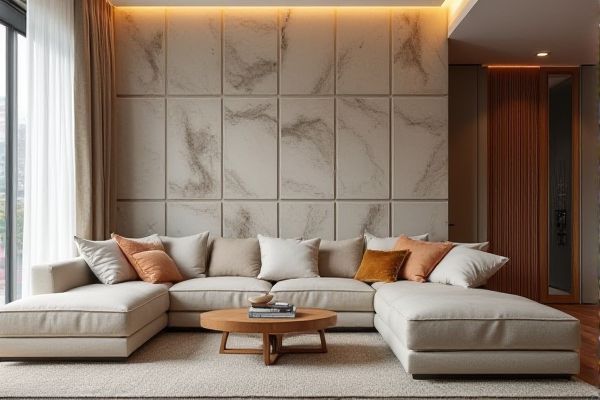
An accent wall is typically a single wall in a room painted or decorated differently to create visual interest, while a feature wall often incorporates more elaborate design elements such as textures, patterns, or artwork to become the focal point. Explore the rest of the article to discover how choosing between an accent wall and a feature wall can transform your living space.
Table of Comparison
| Aspect | Accent Wall | Feature Wall |
|---|---|---|
| Definition | A single wall painted or decorated differently to highlight a space. | A wall designed with distinct materials, patterns, or elements to attract focus. |
| Purpose | Create contrast and add color or texture. | Showcase architectural features or design elements. |
| Design Elements | Paint, wallpaper, decals. | Stone, wood paneling, murals, built-ins. |
| Visual Impact | Subtle highlight to complement room decor. | Bold focal point commanding attention. |
| Cost | Generally low to moderate. | Varies; can be high depending on materials used. |
| Installation | Simple and quick. | May require professional installation. |
| Common Usage | Living rooms, bedrooms, offices. | Lobby areas, feature rooms, commercial spaces. |
Introduction to Accent Walls and Feature Walls
Accent walls use a contrasting color or texture on a single wall to create a focal point in a room, enhancing its visual interest without overwhelming the space. Feature walls often incorporate architectural elements, artwork, or unique materials, adding depth and personality that draw attention. Choosing between an accent wall and a feature wall depends on how you want to highlight your space and reflect your style effectively.
Defining Accent Walls
An accent wall is a single wall in a room painted or decorated differently from the other walls to create a focal point. It typically uses bold colors, distinctive textures, or wallpaper to highlight architectural features or add depth. Unlike a feature wall, which may incorporate art or shelving, an accent wall primarily emphasizes color and material contrast.
What is a Feature Wall?
A feature wall is a single wall in a room designed to draw attention through distinct colors, textures, or materials, creating a focal point that enhances the overall aesthetic. Unlike an accent wall, which typically emphasizes a bold color contrast, a feature wall can incorporate elements such as wallpaper, artwork, or architectural details to add depth and character. You can transform your living space by choosing a feature wall that reflects your style and elevates the room's ambiance.
Key Differences: Accent Wall vs Feature Wall
An accent wall is typically a single wall painted or decorated differently to create visual interest, while a feature wall incorporates elements like texture, wallpaper, or artwork to become the room's focal point. Accent walls often emphasize color contrast, whereas feature walls focus on design complexity and thematic expression. Your choice depends on whether you want a subtle highlight or a bold statement piece in your interior design.
Design Purposes and Intentions
An accent wall emphasizes a single wall through bold color, texture, or pattern to create a focal point and add visual interest without overwhelming the space. A feature wall extends this concept by incorporating architectural details, artwork, or mixed materials, aiming to enhance the room's character and storytelling. Both design choices strategically influence spatial perception and mood but differ in complexity and narrative impact.
Popular Materials and Finishes
Popular materials for accent walls include textured wallpapers, reclaimed wood panels, and bold paint colors, creating striking focal points in rooms. Feature walls often incorporate decorative elements such as stone veneers, brick cladding, or large-scale murals to add depth and character. Matte, glossy, and metallic finishes enhance both accent and feature walls, with options like high-gloss paint or textured plaster providing varied tactile and visual effects.
Color Selection Strategies
Accent wall color selection strategies often emphasize deep, contrasting hues like navy blue or charcoal to create a bold visual impact, while feature wall color choices prioritize harmonizing tones that complement surrounding decor for a cohesive look. Accent walls typically use singular, intense shades to draw attention to one architectural element, whereas feature walls may incorporate textures, patterns, or multiple colors to enhance design complexity. Strategic color contrast and coordination help define the function and mood of both wall types in interior spaces.
Placement and Room Considerations
Accent walls are typically placed on a single dominant wall to draw attention and create a focal point, often behind key elements like beds or fireplaces. Feature walls can incorporate textures, patterns, or artwork and may be located in less conventional areas such as hallways or dining rooms to enhance overall aesthetics. Both require careful consideration of room size, natural light, and existing decor to maintain balance and harmony in the space.
Pros and Cons of Each Option
Accent walls create a bold focal point with a single color or texture, enhancing room depth but may limit design flexibility if trends change. Feature walls incorporate diverse materials, artwork, or patterns, offering more personalization yet potentially overwhelming the space if not balanced. Your choice depends on how much visual impact you want and your willingness to update the design over time.
Choosing the Right Wall for Your Space
Choosing the right wall for your space involves understanding the difference between an accent wall and a feature wall: an accent wall typically uses a bold color or texture to create visual interest, while a feature wall incorporates elements like artwork, shelving, or unique materials to become a focal point. Consider the room's size, lighting, and overall design theme to decide which approach enhances the space without overwhelming it. Measuring the impact of color contrast and decorative features ensures the chosen wall complements your interior style and personal preferences effectively.
 homyna.com
homyna.com